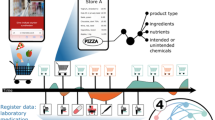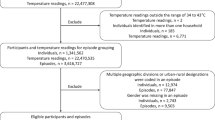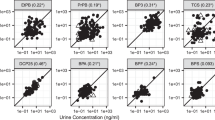Abstract
Traditionally, use of household and personal care products has been collected through questionnaires, which is very time consuming, a burden on participants, and prone to recall bias. As part of the SUPERB Project (Study of Use of Products and Exposure-Related Behaviors), a novel platform was developed using bar codes to quickly and reliably determine what household and personal care products people have in their homes and determine the amount used over a 1-week period. We evaluated the acceptability and feasibility of our methodology in a longitudinal field study that included 47 California households, 30 with young children and 17 with an older adult. Acceptability was defined by refusal rates; feasibility was evaluated in terms of readable bar codes, useful product information in our database for all readable barcodes, and ability to find containers at both the start and end of the week. We found 63% of personal care products and 87% of the household care products had readable barcodes with 47% and 41% having sufficient data for product identification, respectively and secondly, the amount used could be determined most of the time. We present distributions for amount used by product category and compare inter- and intra-person variability. In summary, our method appears to be appropriate, acceptable, and useful for gathering information related to potential exposures stemming from the use of personal and household care products. A very low drop-out rate suggests that this methodology can be useful in longitudinal studies of exposure to household and personal care products.
This is a preview of subscription content, access via your institution
Access options
Subscribe to this journal
Receive 6 print issues and online access
$259.00 per year
only $43.17 per issue
Buy this article
- Purchase on Springer Link
- Instant access to full article PDF
Prices may be subject to local taxes which are calculated during checkout




Similar content being viewed by others
References
Centers for Disease Control and Prevention.. Third National Report on Human Exposure to Environmental Chemicals. Centers for Disease Control and Prevention, Atlanta, GA, USA, 2005.
Daughton C.G., and Ternes T.A. Pharmaceuticals and personal care products in the environment: agents of subtle change? Environ Health Perspect 1999: 107: 907–938.
Golden R., Gandy J., and Vollmer G. A review of the endocrine activity of parabens and implications for potential risks to human health. Crit Rev Toxicol 2005: 35: 435–458.
Hertz-Picciotto I., Cassady D.L., Lee K., Bennett D.H., Ritz B., and Vogt R. Study of use of products and exposure-related behaviors (SUPERB): study design, methods, and preliminary results. Environ Health 2010: 9: 54.
Li T.H., Turpin B.J., Shields H.C., and Weschler C.J. Indoor hydrogen peroxide derived from ozone/d-limonene reactions. Environ Sci Technol 2002: 36: 3295–3302.
Nazaroff W.W., and Weschler C.J. Cleaning products and air fresheners: exposure to primary and secondary air pollutants. Atmos Environ 2004: 38: 2841–2865.
Peck J.D., Hulka B.S., Savitz D.A., Baird D., Poole C., and Richardson B.E. Accuracy of fetal growth indicators as surrogate measures of steroid hormone levels during pregnancy. Am J Epidemiol 2003: 157: 258–266.
Reiss R., Ryan P.B., Tibbetts S.J., and Koutrakis P. Measurement of organic-acids, aldehydes, and ketones in residential environments and their relation to ozone. J Air Waste Manag Assoc 1995: 45: 811–822.
Schettler T. Human exposure to phthalates via consumer products. Int J Androl 2006: 29: 134–139.
Singer B.C., Coleman B.K., Destaillats H., Hodgson A.T., Lunden M.M., Weschler C.J., and Nazaroff W.W. Indoor secondary pollutants from cleaning product and air freshener use in the presence of ozone. Atmos Environ 2006: 40: 6696–6710.
Stickney J.A., Sager S.L., Clarkson J.R., Smith L.A., Locey B.J., Bock M.J., Hartung R., and Olp S.F. An updated evaluation of the carcinogenic potential of 1,4-dioxane. Regul Toxicol Pharmacol 2003: 38: 183–195.
Szczurko C., Dompmartin A., Michel M., Moreau A., and Leroy D. Photocontact allergy to oxybenzone — 10 years of experience. Photodermatol Photoimmunol Photomedicine 1994: 10: 144–147.
US Environmental Protection Agency. Exposure Factors Handbook. National Center for Environmental Assessment, Office of Research and Development, 1997.
US Government Accountability Office.. Chemical Regulation: Options Exist to Improve EPA's Ability to Assess Health Risks and Manage Its Chemcial Review program (Report to Congressional Requesters). Wahsington, DC, USA, 2005.
Van Engelen J.G.M., Heinemeyer G., and Rodriguez C. Consumer exposure scenarios: development, challenges and possible solutions. J Expo Sci Environ Epidemiol 2007: 17: S26–S33.
Vuori V., Zaleski R.T., and Jantunen M.J. ExpoFacts - an overview of European exposure factors data. Risk Anal 2006: 26: 831–843.
Wainman T., Zhang J.F., Weschler C.J., and Lioy P.J. Ozone and limonene in indoor air: a source of submicron particle exposure. Environ Health Perspect 2000: 108: 1139–1145.
Weegels M.F., and van Veen M.P. Variation of consumer contact with household products: a preliminary investigation. Risk Anal 2001: 21: 499–511.
Weschler C.J. Ozone in indoor environments: concentration and chemistry. Indoor Air 2000: 10: 269–288.
Weschler C.J. Ozone's impact on public health: contributions from indoor exposures to ozone and products of ozone-initiated chemistry. Environ Health Perspect 2006: 114: 1489–1496.
Weschler C.J., Brauer M., and Koutrakis P. Indoor ozone and nitrogen-dioxide — a potential pathway to the generation of nitrate radicals, dinitrogen pentaoxide, and nitric-acid indoors. Environ Sci Technol 1992: 26: 179–184.
Weschler C.J., and Shields H.C. Measurements of the hydroxyl radical in a manipulated but realistic indoor environment. Environ Sci Technol 1997: 31: 3719–3722.
Weschler C.J., and Shields H.C. Indoor ozone/terpene reactions as a source of indoor particles. Atmos Environ 1999: 33: 2301–2312.
Wolkoff P., Schneider T., Kildeso J., Degerth R., Jaroszewski M., and Schunk H. Risk in cleaning: chemical and physical exposure. Sci Total Environ 1998: 215: 135–156.
Xue J.P., McCurdy T., Spengler J., and Ozkaynak H. Understanding variability in time spent in selected locations for 7–12-year old children. J Expo Anal Env Epid 2004: 14: 222–233.
Acknowledgements
The project was supported by the United States Environmental Protection Agency (Grant # RD-83154001-0). We thank all of our study participants and our field staff (Jessica Riley, Valerie Moore, Laura Gonzalez, Brianna Diaz, and Karen Wagner).
Author information
Authors and Affiliations
Corresponding author
Ethics declarations
Competing interests
The authors declare no conflict of interest.
Additional information
Supplementary Information accompanies the paper on the Journal of Exposure Science and Environmental Epidemiology website
Supplementary information
Rights and permissions
About this article
Cite this article
Bennett, D., Wu, X., Teague, C. et al. Passive sampling methods to determine household and personal care product use. J Expo Sci Environ Epidemiol 22, 148–160 (2012). https://doi.org/10.1038/jes.2011.40
Received:
Accepted:
Published:
Issue Date:
DOI: https://doi.org/10.1038/jes.2011.40



